About The Ventus & Stella Australis
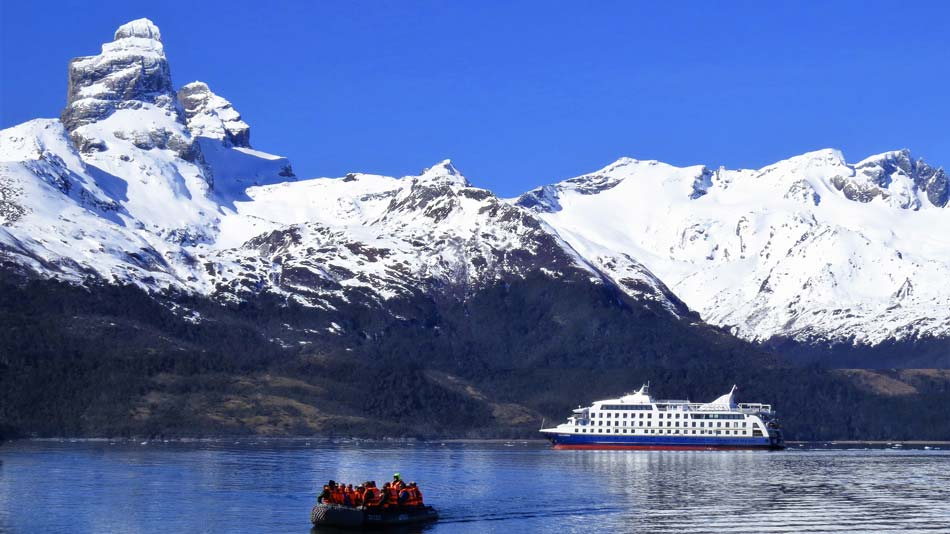
V
entus Australis is the name announced for the new state-of-the-art ship being built for Australis Expedition cruise line. The name – Latin for "Southern Wind" – reflects Tierra del Fuego's distinctive weather, a factor that has long determined the region's socio-cultural development and that so impressed the early mariners who endeavored to explore Patagonia's southernmost waterways.Tailor-made for exploring the remote southern tip of South America, all aspects of the 210-passenger ship -- including size, length, draft and engine power -- are designed to give Ventus Australis the extreme maneuverability necessary to navigate narrow fjords and channels where no other cruise ships can venture. Asenav, the internationally acclaimed Chilean shipyard, is creating our latest masterpiece, just as they did with the three other expedition ships for Australis. Ventus Australis will feature the latest regulations regarding safety at sea and protecting the marine environment, as all of our fleet does.
Ventus Australis will give travelers a chance to experience the remoteness of Patagonia and step ashore at fabled Cape Horn.
Features
Launching season: 2017-2018
First Departure:January 2nd, 2018
Passenger Capacity: 210
Total Cabins: 100
Life Onboard Australis
Among the best in our class anywhere on the planet, Australis
expedition ships offer a level of comfort, safety and efficiency
rarely found in such remote places. Spacious cabins feature cozy
beds, full bathrooms and panoramic views of the Patagonian
nature unfolding outside.
The pampering continues in the dining room with buffet
breakfasts and lunches and four-course dinners that blend
continental and Chilean cuisine.
The galley also caters to special dietary requests.The
all-inclusive bar features a wide selection of liquors,
excellent Chilean wines and local craft beers, as well as our
trademark Calafate Sour. Passengers have access to a library
with extensive literature on Patagonian flora, fauna and
history, as well as board games and other onboard entertainment
activities.
Shore excursions are carried out in Zodiac boats that can easily
navigate remote bays and shallow water. During the journey, our
English-speaking guides and guest lecturers deliver
presentations and slide shows on various aspects of Patagonia
and Tierra del Fuego.
ABOUT THE CABINS & DECKS:
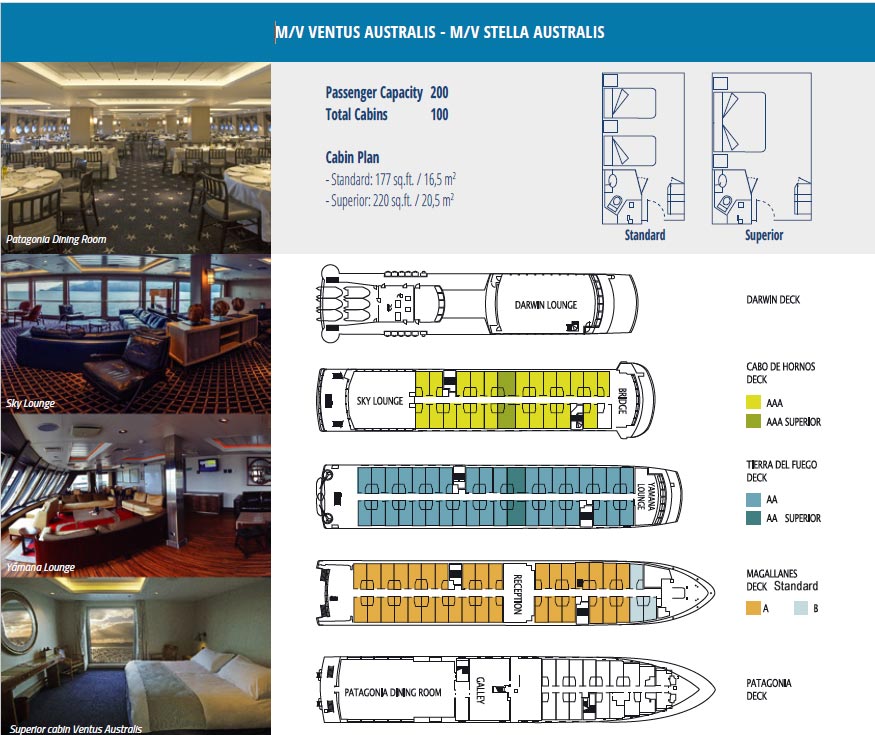
ITINERARIES
Itinerary Fjords of Tierra del Fuego
5 days/4 nights
Punta Arenas to Usuhaia
DAY 1 Punta Arenas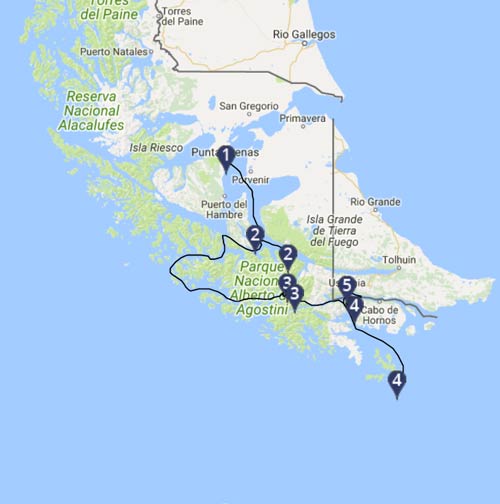
Check in at 1385 O’Higgins Street (Arturo Prat Port) in Punta
Arenas between 13:00 and 17:00 (1-5 PM) on the day of your
Australis cruise departure. Board the M/V Stella Australis (6
PM). After a welcoming toast and introduction of captain and
crew, the ship departs for one of the remotest corners of planet
Earth. During the night we cross the Strait of Magellan and
enter the labyrinth of channels that define the southern extreme
of Patagonian. The twinkling lights of Punta Arenas gradually
fade into the distance as we enter the Whiteside Canal between
Darwin Island and Isla Grande de Tierra del Fuego.
DAY 2 Ainsworth Bay - Tuckers Islets
By dawn the ship is sailing up Admiralty Sound (Seno
Almirantazgo), a spectacular offshoot of the Strait of Magellan
that stretches nearly halfway across Tierra del Fuego. The
snowcapped peaks of Karukinka Natural Park stretch along the
north side of the sound, while the south shore is defined by the
deep fjords and broad bays of Alberto de Agostini National Park.
We go ashore at Ainsworth Bay, which harbors copious bird life
and a colony of southern elephant seals which can sometimes be
spotted from the Zodiacs. Two guided excursions are available:
one is along the edge of a stream, peat bog and beaver habitat
to a waterfall-and-moss-covered rock face tucked deep inside a
pristine sub-polar forest; the other is a more strenuous hike
along the crest of a glacial moraine. Both afford views of
Marinelli Glacier and the Darwin Mountains.
Leaving our Ainsworth Bay tour behind, we sail west along the
sound to the Tucker Islets. After lunch, we board the Zodiacs
again for a close-up view of the Magellan penguins that inhabit
the tiny islands. More than 4,000 penguins use Tucker as a place
to nest, give birth and nurture their chicks. Many other bird
species also frequent the area including king cormorants,
oystercatchers, Chilean skuas, kelp geese, dolphin gulls, eagles
and even the occasional Andean condor. In September and April --
when the penguins live elsewhere -- this excursion is replaced
by a short walk to a glacier at nearby stunning Brookes Bay.
DAY 3 Pia Glacier - Glacier Alley
Overnight we sail around the western end of Tierra del Fuego via
the very narrow Gabrial Channel, Magdalena Channel and Cockburn
Channel. After rounding the remote Brecknock Peninsula, Stella
Australis tacks eastward and enters the Beagle Channel again. By
morning we are entering Pia Fjord and boarding the Zodiacs for a
Pia Glacier tour. After disembarking we take a short hike to
gain a panoramic view of the spectacular glacier, which extends
from the mountaintops down to the sea or a longer much more
difficult walk up a lateral moraine of the old Pia Glacier.
No one knows for certain how the hulking mass of snow and ice
got its feminine moniker, but one theory says it was named for
Princess Maria Pia of Savoy (1847-1911), daughter of the Italian
king.
Back onboard the ship, we continue east along the Beagle Channel
through an area called Glacier Alley. Living up to its name, the
passage features a number of impressive tidewater glaciers
flowing down from the Darwin Mountains and Darwin Ice Sheet on
the north shore. Most of them named after European countries --
Holland, Italy, Germany, Spain and France.
DAY 4 Wulaia Bay - Cape Horn
During the early morning we navigate the narrow Murray Channel
between Navarino and Hoste islands and drop anchor at historic
Wulaia Bay, one of the few places in the archipelago where the
human history is just as compelling as the natural environment.
Originally the site of one of the region’s largest Yámana
aboriginal settlements, the bay was described by Charles Darwin
and sketched by Captain FitzRoy in the 1830s during their
voyages on the HMS Beagle. This area is also renowned for its
mesmerizing beauty and dramatic geography. After a visit to the
Australis-sponsored museum in the old radio station -- which is
especially strong on the Yámana people and European missionaries
in the area -- passengers have a choice of three hikes (of
increasing degrees of difficulty) that ascend the heavily wooden
mountain behind the bay. On all of these you will be strolling
through an enchanted Magellan forest of lengas, coigües,
canelos, ferns, and other endemic fauna to reach a panoramic
viewpoint overlooking the bay. Before leaving Wulaia Bay, drop
something into the wooden mail barrel inside the museum –
letters or postcards meant to be hand delivered by future
travelers – an ancient mariner tradition revived by Australis.
In the afternoon we cruise across Nassau Bay into the remote
archipelago that includes Cape Horn National Park. Weather and
sea conditions permitting, we shall go ashore on the windswept
island that harbors legendary Cape Horn (Cabo de Hornos).
Discovered in 1616 by a Dutch maritime expedition -- and named
after the town of Hoorn in West Friesland -- Cape Horn is a
sheer 425-meter (1,394-foot) high rocky promontory overlooking
the turbulent waters of the Drake Passage. For many years it was
the only navigation route between the Pacific and Atlantic, and
was often referred to as the "End of the Earth." The park was
declared a World Bio
sphere Reserve by UNESCO in 2005. The
Chilean navy maintains a permanent lighthouse on the island,
staffed by a lightkeeper and his family, as well as the tiny
Stella Maris Chapel and modern Cape Horn Monument.
DAY 5 Ushuaia
The following morning we sail into Argentine waters and dock in
Ushuaia, the world's southernmost city.
Arrival at 08:30 a.m. and 9:30 am according to date of
departure.
Itinerary Patagonia Explorer
5 days/4 nights
Ushuaia-Punta Arenas
DAY 1 Ushuaia: Check in at 409 San Martín Ave. in downtown Ushuaia between 10:00 and 17:00 (10 AM-5 PM) on the day of your cruise departure. Board the M/V Ventus Australis at 18:00 (6 PM). After a
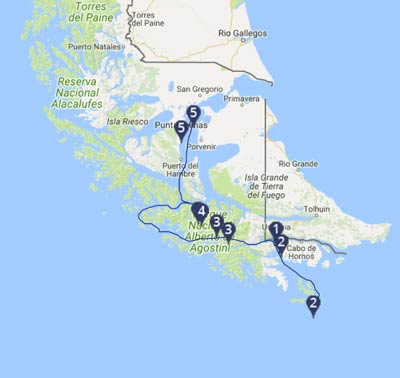
welcoming toast and introduction of captain and crew, the ship
departs for one of the most remote corners of planet Earth.
During the night we traverse the Beagle Channel and cross from
Argentina into Chilean territorial waters. The lights of Ushuaia
disappear as we turn into the narrow Murray Channel between
Navarino and Hoste islands.
DAY 2 Cape Horn - Wulaia Bay
Around the break of dawn, Stella Australis crosses Nassau Bay
and enters the remote archipelago that comprises Cape Horn
National Park. Weather and sea conditions permitting, we shall
go ashore on the windswept island that harbors legendary Cape
Horn (Cabo de Hornos). Discovered in 1616 by a Dutch maritime
expedition -- and named after the town of Hoorn in West
Friesland -- Cape Horn is a sheer 425-meter (1,394-foot) high
rocky promontory overlooking the turbulent waters of the Drake
Passage. For many years it was the only navigation route between
the Pacific and Atlantic, and was often referred to as the "End
of the Earth." The park was declared a World Biosphere Reserve
by UNESCO in 2005. The Chilean navy maintains a permanent
lighthouse on the island, staffed by a lightkeeper and his
family, as well as the tiny Stella Maris Chapel and modern Cape
Horn Monument (currently awaiting repair after being damaged by
fierce winds).
Sailing back across Nassau Bay, we anchor at fabled Wulaia Bay,
one of the few places in the archipelago where the human history
is just as compelling as the natural environment. Originally the
site of one of the region’s largest Yámana aboriginal
settlements, the bay was described by Charles Darwin and
sketched by Captain FitzRoy in the 1830s during their voyages on
HMS Beagle. This area is also renowned for its mesmerizing
beauty and dramatic geography. After a visit to the
Australis-sponsored museum in the old radio station -- which is
especially strong on the Yámana people and European missionaries
in the area -- passengers have a choice of three hikes (of
increasing degrees of difficulty) that ascend the heavily wooded
mountain behind the bay. On all of these you stroll through an
enchanted Magellanic forest of lengas, coigües, canelos and
ferns to reach panoramic viewpoints overlooking the bay.
DAY 3 Pía Glacier – Garibaldi Glacier
Overnight we continue our Patagonia glacier tour around the
western end of Tierra del Fuego via the very narrow Gabrial
Channel, Magdalena Channel and Cockburn Channel. After rounding
the remote Brecknock Peninsula, Ventus Australis tacks eastward
and enters the Beagle Channel again. By morning we are entering
Pia Fjord and boarding the Zodiacs for a shore excursion to Pia
Glacier.After disembarking we take a short hike to gain a
panoramic view of the spectacular glacier, which extends from
the mountaintops down to the sea or a longer much more difficult
walk up a lateral moraine of the old Pia Glacier.
No one knows for certain how the hulking mass of snow and ice
got its feminine moniker, but one theory says it was named for
Princess Maria Pia of Savoy (1847-1911), daughter of the Italian
king.
Making our way further west along the Beagle Channel, we enter
another long fjord and drop anchor near Garibaldi Glacier for
another shore excursion. Garibaldi is one of only three glaciers
in Patagonia gaining mass rather than staying the same or slowly
shrinking. This time we hike through virgin Magellanic forest to
a glacial waterfall, a towering wall of ferns and moss, and
spectacular viewpoints looking down on the glacier and fjord.
The walk is demanding -- very steep, negligible trail, rough
footing -- and not for everyone. For those who choose to stay
onboard, our captain will point the bow towards the beautiful
sky blue Garibaldi Glacier so everyone can enjoy the panoramic
view from the upper decks.
DAY 4 Agostini Sound – Águila Glacier – Cóndor Glacier
Early in the morning, we will sail through the Cockburn Channel
and enter Agostini Sound. From there it is possible to see the
glaciers that descend from the middle of the Darwin Mountain
Range -- some of them reaching the water. This morning, we will
disembark and go for an easy walk around a lagoon, which was
formed by the melting of the Águila Glacier. We will reach a
spot right in front of that glacier with stunning views. In the
afternoon, we will approach the Condor Glacier via Zodiac -- and
hopefully see some of the abundant Andean Condors in the area.
DAY 5 Magdalena Island - Punta Arenas
After an overnight cruise through Magdalena Channel and back
into the Strait of Magellan, we anchor off Magdalena Island,
which lies about halfway between Tierra del Fuego and the
Chilean mainland. Crowned by a distinctive lighthouse, the
island used to be an essential source of supplies for navigators
and explorers and is inhabited by an immense colony of
Magellanic penguins. At the break of dawn, weather permitting,
we go ashore and hike a path that leads through thousands of
penguins to a small museum lodged inside the vintage 1902
lighthouse. Many other bird species are also found on the
island. In September and April -- when the penguins dwell
elsewhere -- this excursion is replaced by a ride aboard Zodiacs
to Marta Island to observe South American sea lions. After a
short cruise south along the strait, disembarkation at Punta
Arenas is scheduled for around 11:30 AM.
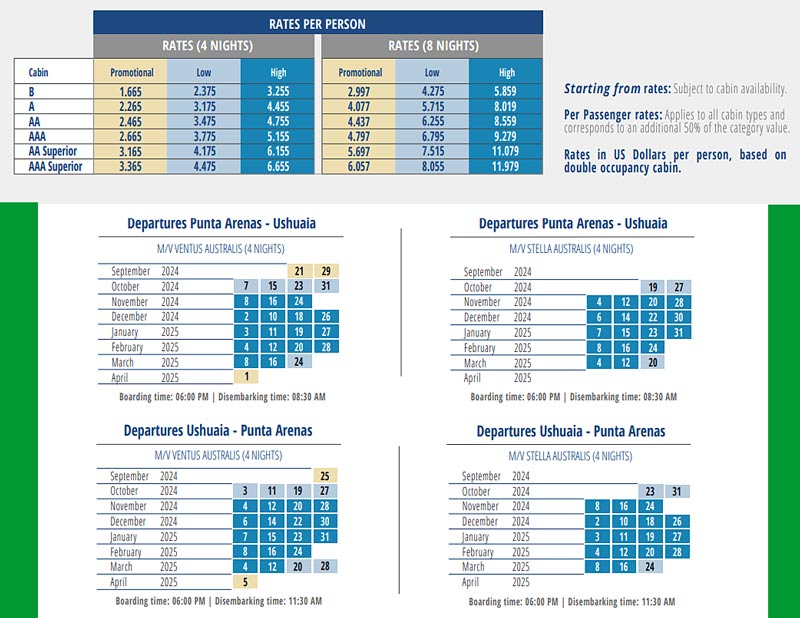
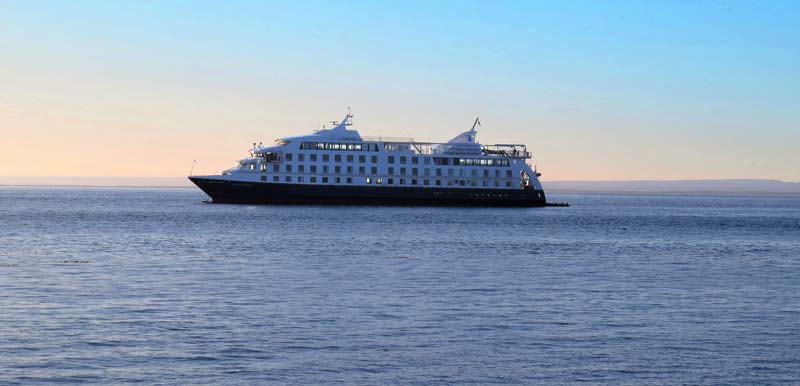
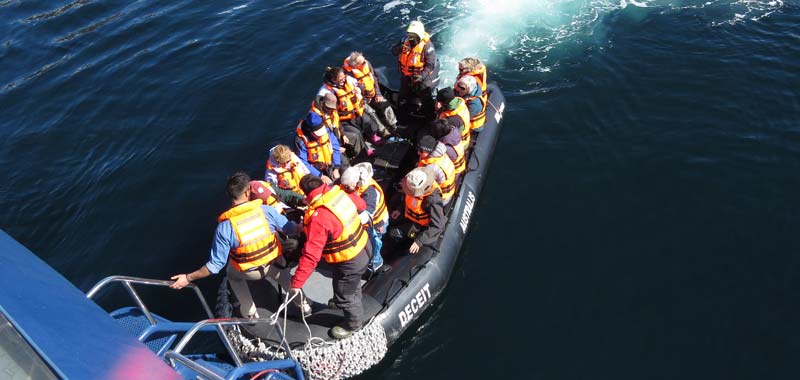
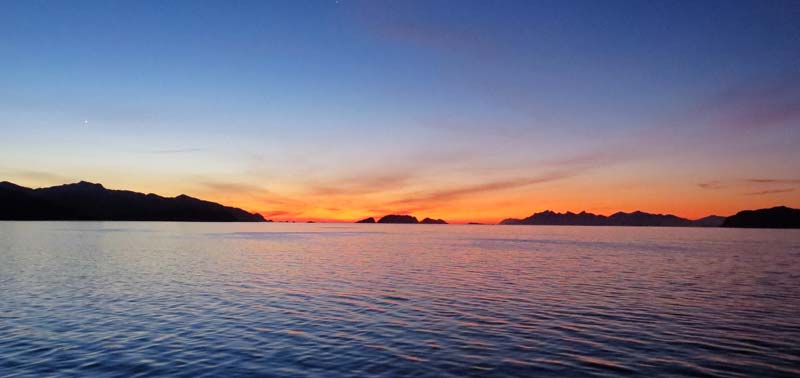
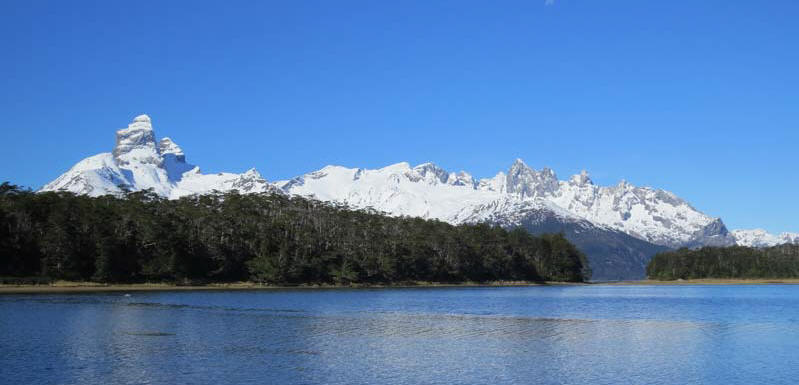
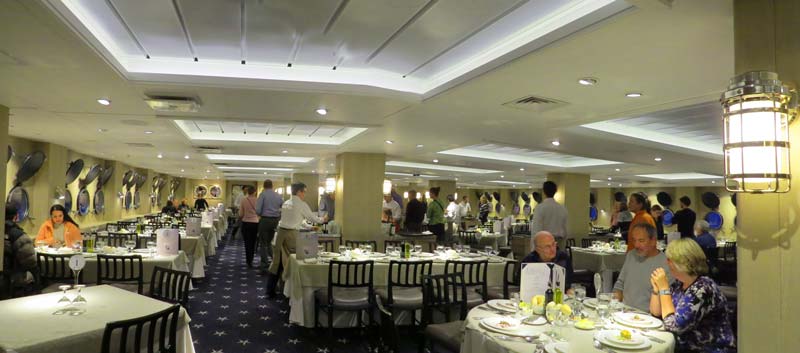
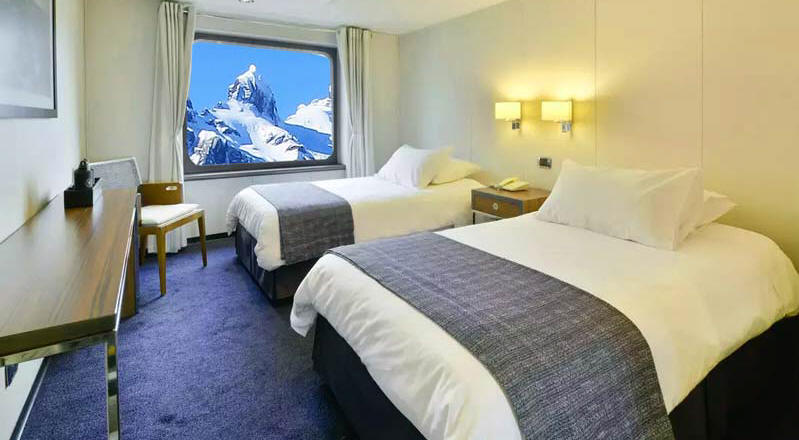
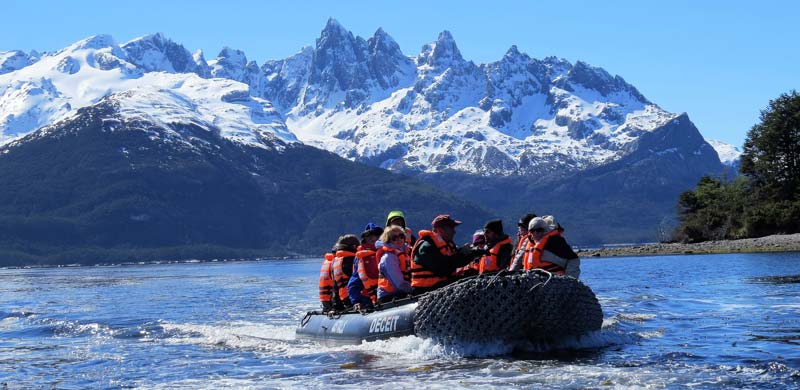
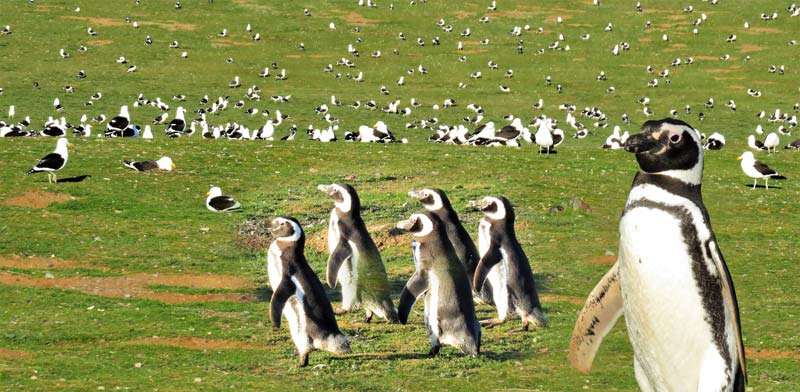
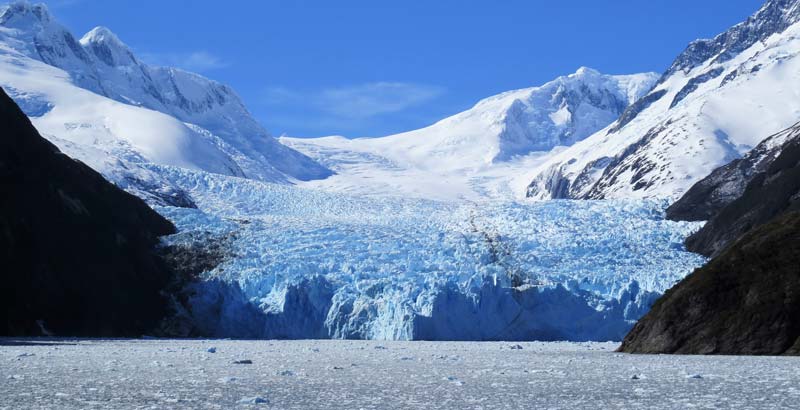
For questions or further information about these
programs
Have your Travel Agent call
Tara Tours at 1-800-327-0080 or
e-mail us tara@taratours.com
